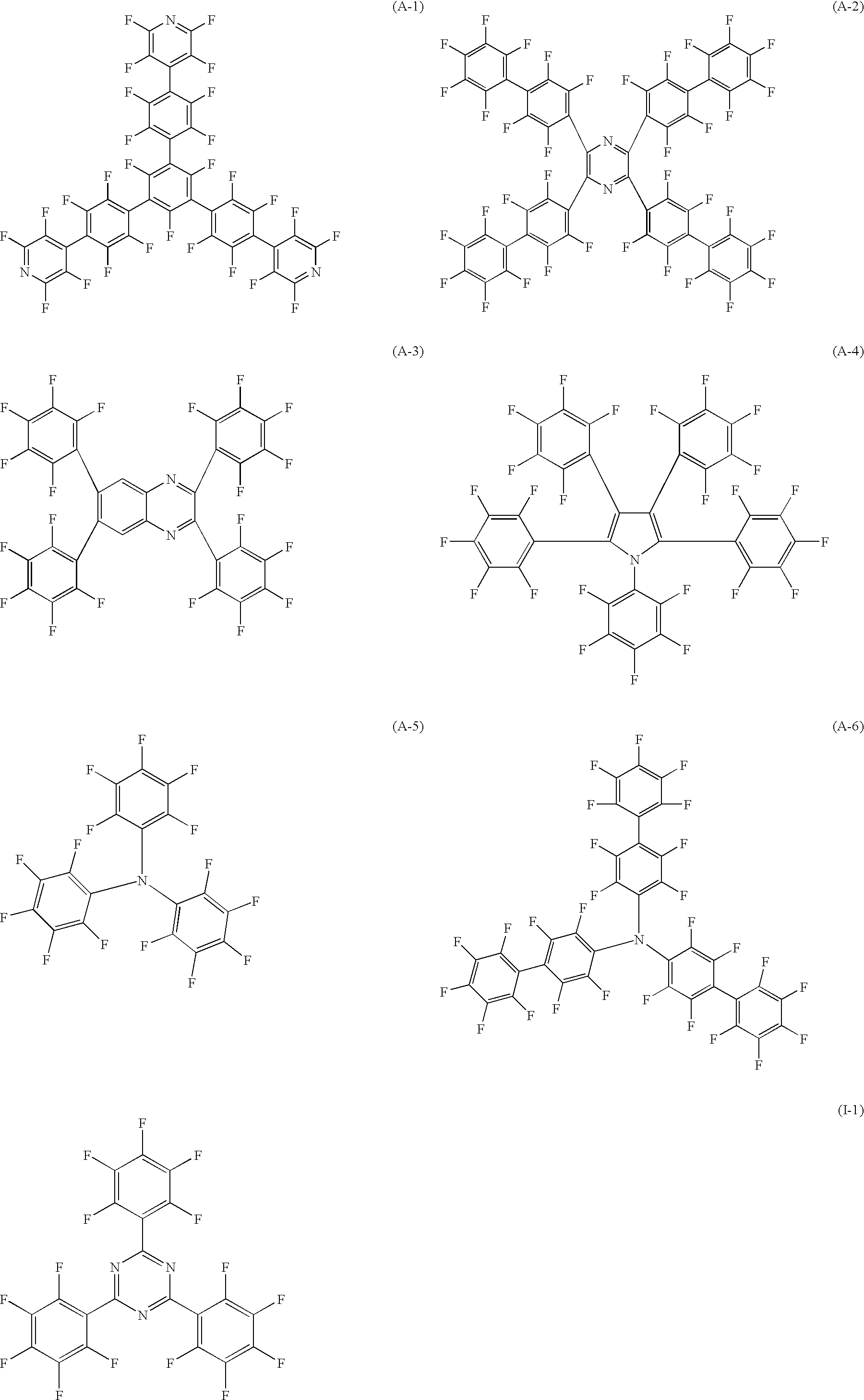Light emitting element
a technology of light-emitting elements and elements, applied in the field of light-emitting elements, can solve problems such as failure to provide sufficient enduran
- Summary
- Abstract
- Description
- Claims
- Application Information
AI Technical Summary
Benefits of technology
Problems solved by technology
Method used
Image
Examples
synthesis example 1
Synthesis of Exemplified Compound (I-1)
[0076]5.0 g of pentafluorobenzene (manufactured by Tokyo Kasei Kogyo Co., Ltd.) was dissolved in 120 mL of tetrahydrofran, and this solution was cooled to −70° C. 18.6 mL of n-butyl lithium / n-hexane solution (1.6 M)(manufactured by Wako Pure Chemical Industries, Ltd.) was slowly dripped thereto for 30 minutes. After completion of the dripping process, the resulting solution was stirred at −70° C. for 30 minutes. 50 mL of tetrahydrofran solution containing 1.83 g of cyanuric chloride (manufactured by Tokyo Kasei Kogyo Co., Ltd.) was dripped thereto at −70° C., and the resulting solution was heated to room temperature, and stirred for 1 hour at room temperature. The reaction product was put into water, and a deposited white solid matter was filtered out, and sufficiently washed with methanol and chloroform. After being dried, the structure of the example compound (I-1) was confirmed by using a mass-spectrum.
[0077]
example 1
Preparation of Organic EL Element
[0078]A glass substrate having dimensions of 25 mm×25 mm×0.7 mm, on which ITO was coated at a thickness of 150 nm (manufactured by Sanyo Vacuum Industries Co., Ltd.), was used as a transparent supporting substrate. After etching and washing the glass substrate, TPD (N,N′-diphenyl-N,N′-di(m-tolyl)-benzidine) was vapor-deposited thereon to a thickness of 50 nm, the following compounds a and b were vapor-deposited thereon at a mass ratio of 34:2 to a thickness of 36 nm, and the exemplified compound (I-1) was further vapor-deposited thereon at a thickness of 36 nm.
[0079]After providing a patterned mask (providing a light emission area of 4 mm×5 mm) on the organic thin film, lithium fluoride was vapor-deposited to a thickness of 3 nm, and then aluminum was vapor-deposited to a thickness of 60 nm, whereby an organic EL element of example 1 was produced.
Evaluation
Evaluation Method
[0080]The resulting organic EL element was subjected to light emission by appl...
example 2
[0089]α-NPD (N,N′-diphenyl-N,N′-di(α-naphthyl)-benzidine) was vapor-deposited to a thickness of 40 nm on an ITO substrate washed in the same manner as in example 1, a compound d shown below (blue light emitting material) was vapor-deposited to a thickness of 20 nm, and the exemplified compound (I-1) was vapor-deposited thereon to a thickness of 40 nm.
[0090]After providing a patterned mask (providing a light emission area of 4 mm×5 mm) on the obtained organic thin film, magnesium and silver (10 / 1) were simultaneously vapor-deposited to a thickness of 50 nm, and then silver was vapor-deposited to a thickness of 50 nm, whereby an organic EL element of example 2 was produced.
[0091]
[0092]The resulting organic EL element was evaluated in the same manner as in example 1. As a result, light emission with CIE chromaticity coordinates of (x, y)=(0.15, 0.28) was obtained, and the external quantum efficiency thereof was 3.0% (light emission from an excitation singlet state).
[0093]The same evalu...
PUM
| Property | Measurement | Unit |
|---|---|---|
| glass transition temperature | aaaaa | aaaaa |
| external quantum efficiency | aaaaa | aaaaa |
| external quantum efficiency | aaaaa | aaaaa |
Abstract
Description
Claims
Application Information
 Login to View More
Login to View More - R&D
- Intellectual Property
- Life Sciences
- Materials
- Tech Scout
- Unparalleled Data Quality
- Higher Quality Content
- 60% Fewer Hallucinations
Browse by: Latest US Patents, China's latest patents, Technical Efficacy Thesaurus, Application Domain, Technology Topic, Popular Technical Reports.
© 2025 PatSnap. All rights reserved.Legal|Privacy policy|Modern Slavery Act Transparency Statement|Sitemap|About US| Contact US: help@patsnap.com



